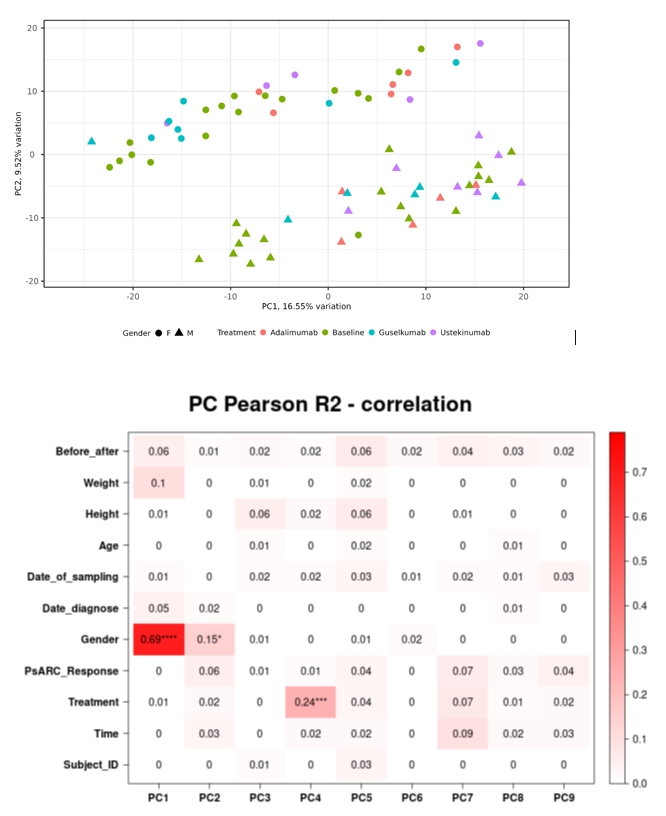Session Information
Date: Monday, November 18, 2024
Title: SpA Including PsA – Diagnosis, Manifestations, & Outcomes Poster III
Session Type: Poster Session C
Session Time: 10:30AM-12:30PM
Background/Purpose: Psoriatic arthritis (PsA) is a highly heterogenous chronic inflammatory condition. Recent publications highlight differences between men and women in disease manifestation and response to therapy (ref. 1, 2). Therefore, an understanding of sex- and gender-related differences in PsA, as well as the underlying mechanisms for these, is important for individualized care. Our aim was to assess the molecular effects of specific bDMARDs (adalimumab-ADA, guselkumab-GUS, ustekinumeb-UST) in the synovium and blood with specific attention to gender differences.
Methods: In this multicentre prospective randomized trial (TNFα and IL-23 blockers gene expression ratios in PsA – TIGERS study, NCT04261010), csDMARD-resistant PsA patients were divided into three groups according to their randomly received bDMARD (ADA, GUS, UST), and stratified in two groups (oligo-PsA and poly-PsA). We assessed disease activity clinically and biologically at baseline (BL) and every 6 weeks through week 24 (W24). The psoriatic arthritis response criteria (PsARC) was used to assess clinical response to therapy at W24. Patients underwent needle arthroscopy for knee synovial biopsy and blood sample collection at BL and at 24 weeks after initiation of a bDMARD. We performed RNA sequencing (NGS – Illumina) using the BL and W24 synovium and blood samples (Paxgene). The local institutional review board and regulatory authorities approved the study.
Results: We assessed 36 patients; 50% were men. Mean (SD) age was 48.5 (13.8) years, and mean disease duration was 45.5 (47.3) months. Principal component analysis (PCA) revealed that gender difference caused variation across all samples. Figures 1-2 represent the PCA results for blood and figures 3-4 for synovium samples stratified by gender, time of assessment, and treatment. There is a highly significant Pearson correlation driven by the gender, both in the blood (fig. 2) and synovium (fig. 4).
Conclusion: In the TIGERS study, differences in blood and synovium transcriptomic profile between men and women, even before a bDMARD initiation, were observed. Additional analyses are ongoing to better characterize the pathways involved in this molecular pattern difference and further inform tailoring our therapeutic strategy.
REFERENCES:
< ![if !supportLists] >1) < ![endif] >Tarannum S, Leung YY, Johnson SR, Widdifield J, Strand V, Rochon P, Eder L.
Sex- and gender-related differences in psoriatic arthritis. Nat Rev Rheumato. 2022 Sep;18(9):513-526
< ![if !supportLists] >2) < ![endif] >Coates LC, van der Horst-Bruinsma IE, Lubrano E, Beaver S, Drane E, Ufuktepe B, Ogdie AR. Sex-Specific Differences in Patients with Psoriatic Arthritis: A Systematic Review. J Rheumatol. 2023 Apr; 50(4):488-496.
Figure 2: Principal component Pearson correlation done in the blood sample (Paxgene)
Figure 4: Principal component Pearson correlation in the synovium
To cite this abstract in AMA style:
KRUG P, De Sousa Leite a, Lecouvet F, stoenoiu M, Nzeusseu Toukap A. Gene Expression Profile Is Different Between Men and Women in Psoriatic Disease [abstract]. Arthritis Rheumatol. 2024; 76 (suppl 9). https://acrabstracts.org/abstract/gene-expression-profile-is-different-between-men-and-women-in-psoriatic-disease/. Accessed .« Back to ACR Convergence 2024
ACR Meeting Abstracts - https://acrabstracts.org/abstract/gene-expression-profile-is-different-between-men-and-women-in-psoriatic-disease/


